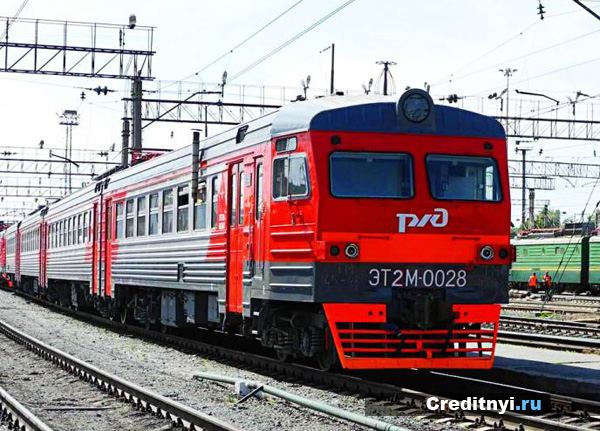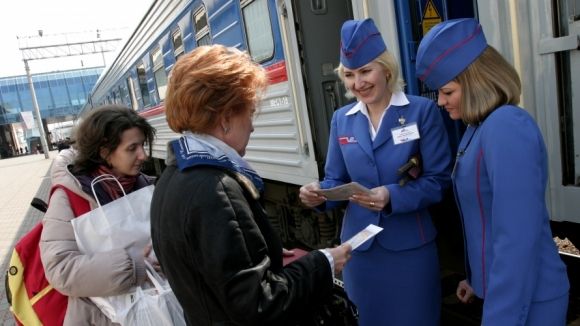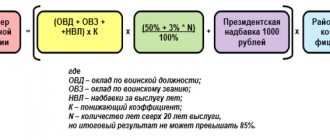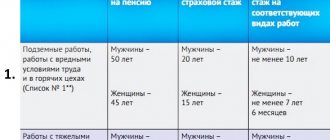Subscribe to news
A letter to confirm your subscription has been sent to the e-mail you specified.
February 10, 2012 04:15
The right to assign an early labor pension to railway transport workers in accordance with the norms of the Federal Law “On Labor Pensions in the Russian Federation” comes to: - men who have reached the age of 55 years, having at least 12 years 6 months of experience in the relevant types of work and at least 25 years of insurance experience; - for women who have reached the age of 50 years, with at least 10 years of experience in relevant types of work and at least 20 years of insurance experience.
The determination of the right to early pension provision is carried out in accordance with the list of professions and positions (hereinafter referred to as the List), approved by Decree of the Government of the Russian Federation of April 24, 1992 No. 272. The list is specified and is not subject to broad interpretation, therefore the periods of labor activity carried out in professions and positions are not provided for in the List do not give the right to include them in the length of service in the relevant types of work for the purpose of granting an early retirement pension.
The list applies not only to railway workers working on the main railways of the Ministry of Railways of the Russian Federation, but also to railway transport workers of enterprises and organizations. For example, the List includes stokers of steam locomotives, drivers and assistant drivers of steam locomotives, diesel locomotives, electric locomotives, train compilers and some other professions without further clarification. These employees are granted a pension due to special working conditions regardless of which railway they work on, as well as regardless of whether they work on mainline railways or in railway transport workshops of enterprises and organizations.
Some railroad employees are entitled to pension benefits if they work on sections of mainline railroads with heavy or particularly heavy train traffic. These include, for example, foremen (exempt) for the routine maintenance and repair of tracks and artificial structures, track fitters, repairmen of artificial structures and others. The additional factor of train traffic intensity in this case is the main condition for assigning a pension and must be reflected in the certificate specifying the special working conditions. Some positions directly depend on what class the station the person works at belongs to. For example, duty officers at railway stations, at hump yards, dispatchers at railway shunting stations, hump operators, wagon inspectors, rolling stock mechanics and others. To count the period of work in the above-mentioned positions into the preferential period of service, it is necessary to know at which stations they work, since railway stations are divided into: extracurricular, I, II, III, IV, and V classes, and working employees enjoy pension benefits not at all stations, but at stations belonging to a certain class. Therefore, this factor must be indicated in the certificate confirming the preferential length of service.
The timeliness and correctness of the assignment of an early retirement pension depends on the quality of the preparatory information and the content of the information provided to the territorial departments of the Pension Fund.
Telephone "Hotline" 2-36-72
Benefits for Russian Railways pensioners: early retirement and a list of other privileges
RZD or Russian Railway Company, which today is one of the largest transport organizations in the world, was formed in 2003 on the basis of the Ministry of Railways.
As an employer that provides employment to about 1.5% of the working population in Russia, it also took care of the benefits available to retired employees.
what these benefits and who is entitled to them.
Who can count on benefits?
In general, all entitlement benefits, including those available after retirement, are initially prescribed in the collective agreement, which is concluded between the employee and the OJSC upon employment.
Otherwise, the scope and list of privileges directly depends on the length of service, the presence of injuries and illnesses received in the performance of duties and other merits.
In addition, Russian Railways employees have the right to early retirement for difficult working conditions (5 years earlier than the generally established age).
Early retirement
In order to qualify for early retirement, you must not only be an employee of Russian Railways, you must meet the following conditions:
- Turning 55 years old for a man or reaching 50 years old for a woman;
- Experience in Russian Railways of 12.5 years or more for men and 10 years or more for women,
- Insurance experience of 25 years or more for men and 20 years or more for women.
Moreover, if the persons listed above have worked for more than half of the specified period in specialties that provide privileges (more about them below) and have sufficient insurance experience, then the insurance pension will be assigned with a decrease in age according to the following algorithm:
- For every 2.5 years of work, 1 year for men;
- For every 2 years of work, 1 year for women.
Specialties that give the right to early retirement
Now let's return to the list of specialties that allow Russian Railways employees to retire early, these are:
- Foreman for track maintenance and repair;
- Duty officers (at marshalling humps and passing trains);
- Dispatchers (of trains and railway stations) and senior train dispatchers in the metro;
- Steam locomotive stokers, as well as drivers and their assistants;
- Freight train conductors;
- Sorting hump operators;
- Linemen of tracks located in areas with heavy traffic;
- Train compilers and carriage inspectors;
- Mechanics and electricians, as well as electricians and repairmen.
In addition, certain specialties may have additional requirements. Therefore, in each specific case, all circumstances (both the presence of experience and work in the specialty, the applicant’s compliance with additional requirements, and their introduction must be confirmed by documents: orders, staffing, certificates, etc.).
Important: the preferential length of service includes work performed full-time, with the exception of periods of illness, vacation, downtime, attendance at advanced training courses, etc.
Other benefits of Russian Railways
All benefits and allowances provided to non-working Russian Railways pensioners are prescribed in collective agreements (the latter, with amendments, was signed for 2019-2020). In accordance with it, privileges are provided even for career employees who dedicated their lives to the railway and include the following:
- Russian Railways employees with more than 20 years of experience have the right to receive free tickets for long-distance trains in a round-trip compartment, with the possibility of two stops along the way for themselves and one of their minor children;
- Free tickets (also if you have 20 years of experience for yourself and one minor child) on commuter trains (for a distance of up to 200 km in both directions) in third-class carriages without additional payments or in first and second-class carriages with an additional payment of the difference from the cost of a third-class ticket class;
- Refusal of free travel for yourself in a reserved seat carriage in favor of your child over 18 years of age (but not over 24 years of age) studying full-time (twice a year during the holidays);
- Russian Railways pensioners who have received the award “Honorary Railway Worker of JSC Russian Railways” or “Honorary Railway Worker” are given a benefit in the form of free travel in a double compartment or on a commuter train for a distance of up to 200 km;
- Former employees of Russian Railways who have the title of Hero (USSR, Russian Federation, Social Labor), as well as holders of the Orders of Glory and Labor Glory, are paid monthly cash assistance in the amount of 7,500 rubles;
Early railway pension
Employees of Russian Railways, like everyone else, upon reaching a certain age receive the right to retire. Employees can receive this right early in old age if they meet the basic requirements:
- Age limit: 50 (women), 55 (men) years. This is the minimum age when a Russian Railways employee can apply for a payment.
- For early retirement, men/women in Russian Railways must have a certain number of years of experience as an employee in a locomotive crew, in the field of railway traffic safety, etc.
When making a payment, the applicant’s profession must be on the List of professions that give him the right to early retirement. The list is quite long:
- railway station duty officers;
- conductors;
- dispatchers;
- repair team foremen;
- stokers;
- masters;
- drivers and their assistants;
- inspectors;
- mechanics;
- locksmiths;
- compilers and others.
The list of professions in the railway transport sector that require early retirement was first published in 1956 and has remained virtually unchanged since then. In addition to suitability for the profession, experience is also important. So, for women it is set at 10 years, for male railway workers - 12 and a half years. The overall length of service is also important - the minimum required length is 25 and 20 years, respectively.
Early retirement is possible even if the number of years of specialized experience is insufficient. The condition is this: those employees who, before the beginning of 1992, worked in the Russian Railways sector for at least 6 years and 3 months or 5 years can receive a preferential pension. However, in this case, the reduction in retirement age will not be 5 years as in the general case, but 2.5 and 2 years, respectively.
Who can retire early?

Males aged fifty-five and females aged fifty, working as drivers of urban public transport for twenty and fifteen years and having work experience of twenty-five and twenty years, are given the opportunity to receive early pension payments.
Bus drivers are provided with a preferential pension when they make regular trips within the locality. This is permanent transportation within the city, carried out by vehicles used for passenger transportation with more than eight seats.
Drivers must regularly transport passengers on a set schedule, picking them up and dropping them off at designated stops. Information about the route is contained in the route passport.
Elena Smirnova
Pension lawyer, ready to answer your questions.
Ask me a question
Drivers may be assigned a preferential pension if their regular employment (at least 80% of the working time) is certified by documents.
Driver employment is determined based on monthly results. The period of monthly employment includes: the period of preparation and completion of work, hours for medical examination, hours for repair work and maintenance.
Drivers who carry out transportation between cities, to the suburbs, special and custom ones, who are not regular city routes, and drivers of departmental vehicles cannot become pensioners early.
NGOs in the field of Russian Railways
Non-state support for railway workers is carried out within the framework of the corporate employee support system. NPF Blagosostoyanie acts as a guarantor for all Russian Railways employees participating in the pension formation program.
Today, more than 600 thousand railway workers take part in this corporate system, and almost 300 thousand receive pensions from the fund’s reserves. The corporate pension of Russian Railways last year had an average size of 6 thousand rubles.

The corporate pension is formed as a double deduction of funds from the Russian Railways employee and the employer. Part of the funds for the funded part of the pension is withheld from salaries, the rest is “reported” by Russian Railways. Employees have the opportunity to choose the optimal scheme for accumulating part of their pension:
- The insurance scheme offers employees the lowest possible premiums. A disadvantage is the fact that such a part of the non-state payment cannot be inherited.
- Savings and insurance. The pension can be inherited, but not earlier and not later than the established date.
- Insurance and savings. You can inherit funds immediately after the appointment of a non-state payment, but not before it.
- Savings. You can inherit funds at any time.
- Scheme 6 provides for the inheritance of money only by the closest relative (or several) even before the payment is assigned.
The funded part of the pension can be received after a Russian Railways employee retires after reaching a specified age. The length of service during which contributions were actively made is also important - at least 5 full years. The rights to the accumulated portion when choosing another NPF are retained by the employee if the new guarantor is a partner of Russian Railways.

The size of the corporate payment is determined by wages, has a minimum volume, and the maximum is not limited. For example, PF employees can show the calculation of the pension of a Russian Railways diesel locomotive driver based on the amount of his last salary - 18-26 thousand rubles monthly, depending on the region. Only days worked in full in the following positions can be taken into account in the length of service required to calculate payments:
- directly in the Russian Railways system;
- in the Ministry of Railways of Russia or the USSR;
- in organizations that were part of these organizations;
- in Komsomol/party institutions in the field of railway transport;
- in railway healthcare institutions;
- NPF “Blagosostoyanie”, as well as “Zhildoripoteka”, “Zhilsotsipoteka”;
- executive authorities in the railway sector and so on.
The average size of non-state payments is growing from year to year. If in 2008 its size was 2,736 rubles, today it has reached a value of 6 thousand rubles monthly. The amount depends on contributions made, length of service and other conditions. The employee chooses the program. In addition to the required contributions in accordance with the selected contribution scheme, each employee can make additional payments to further increase their future pension.
Preferential pensions of the state software are designed to compensate railway workers for health costs, since fulfilling work duties in the Russian Railways sector is often fraught with difficulties. The corporate pension is designed to increase the amount of payment and support employees financially after retirement.
Let's talk about the pensions of Russian Railways employees
Pensions for Russian Railways employees are provided from the Russian Pension Fund. In addition, some working conditions, as well as length of service, allow you to participate in non-state pension insurance. Russian Railways employees have the right to retire earlier , since the tariffing of length of service is carried out with some features.
Early railway pension
You can apply for a pension benefit early if certain conditions are met:
- Achieving the minimum retirement age for employees of JSC Russian Railways - for women, retirement is possible from 50 years old, for men - from 55.
- Having a certain amount of work experience in a position associated with increased danger.
There are a number of positions in the Russian Railways sector that allow you to retire early. These include:
- repair team foreman;
- driver and assistant driver;
- conductor and dispatcher of a railway station;
- mechanic, mechanic, fireman;
- composition compiler;
- inspector
It is important that the employee’s specialty is included in this list, since not all positions are eligible for early retirement.
In the formation of an early pension, the presence of work experience in the position held in the Russian Railways sector plays an important role. For women it is 10 years, for men 12.5 years. The total length of service applying for a pension should not be less than 20 years for women and 25 years for men.
It is possible to receive an early pension if you do not have enough experience, provided that the person worked for Russian Railways for at least 6 years before 1992. In this case, you can apply for a reduction in the retirement age by 2-2.5 years from the generally accepted age.
NGOs in the field of Russian Railways
In addition to state pension insurance, Russian Railways employees can also provide themselves with a pension through the corporate system. This method has recently become more popular and allows you to increase the total amount of payments several times.
The guarantor for Russian Railways employees in the field of pension insurance is the Blagosostoyanie fund, which offers to take care of their future pension from the first day of work in the railway sector.
The average corporate pension is 6,000 rubles, which is a good help.
Conditions for the formation of a corporate pension
The corporate pension is formed through contributions from the employee himself, as well as contributions from the employer (in this case, JSC Russian Railways). Part of the funds is withheld from the employee’s salary, and the rest is paid by the employer.
There are several schemes recommended for creating a corporate pension:
- Insurance - due to minimal contributions to the fund, but cannot be inherited by close relatives.
- Insurance-savings - you can receive payments only when all the conditions for their assignment are met: age, length of service, etc.
- Savings and insurance - the pension is paid no earlier and no later than the established date, can be inherited by close relatives in the event of incapacity of a Russian Railways employee or his premature death.
- Savings - you can receive payments at any time when necessary.
When choosing the terms of pension insurance under a corporate scheme, it is important to take into account the total length of service, age and other additional parameters. The amount of the corporate monthly contribution is equal to the percentage of contributions to the pension fund, but at the request of the employee himself, it can be increased by any amount or percentage of wages.
Right to receive a corporate pension
All employees of Russian Railways who meet the parameters for the assignment of this type of pension and also take part in the program monthly by transferring a certain amount of contribution to the fund can apply for a non-state pension. When transferred to a new position or place of work where the NGO “Blagosostoyanie” is supported, the right to receive a pension is retained.
If a person quits his job in the Russian Railways sector before retirement, he can compensate for the lack of years or experience by increasing the amount of the monthly payment, or by paying off the debt, which is calculated at the time of dismissal. This will allow you to receive a corporate pension upon reaching age while maintaining all payments made previously.
Prospects for further changes to employee pensions
Since the pension reform comes into force on January 1, 2020, which involves a gradual increase in the retirement age, the amount of monthly contributions to the non-state pension fund will vary. Its amount can be reduced or increased at the request of the employee.
Several years ago, the corporate pension for Russian Railways employees did not exceed 3,000 rubles. Today the minimum amount of monthly payments is at least 6,000 rubles. Every year, provided that indexation is maintained, the size of the pension will increase . You can also adjust the amount by voluntarily increasing the amount of monthly contributions to the fund.
Early retirement for railway workers
Employees of Russian Railways, like everyone else, upon reaching a certain age receive the right to retire. Early retirement pensions for railway workers are granted if the following requirements are met:
- Age limit: 50 (women), 55 (men) years. This is the minimum age when a Russian Railways employee can apply for a payment.
- For early retirement, men/women in Russian Railways must have a certain number of years of experience as an employee in a locomotive crew, in the field of railway traffic safety, etc.
When making a payment, the applicant’s profession must be on the List of professions that give him the right to early retirement. The list is quite long:
- railway station duty officers;
- conductors;
- dispatchers;
- repair team foremen;
- stokers;
- masters;
- drivers and their assistants;
- inspectors;
- mechanics;
- locksmiths;
- compilers and others.
The list of professions in the railway transport sector that require early retirement was first published in 1956 and has remained virtually unchanged since then. In addition to suitability for the profession, experience is also important. So, for women it is set at 10 years, for male railway workers - 12 and a half years. The overall length of service is also important - the minimum required length is 25 and 20 years, respectively.
Early retirement is possible even if the number of years of specialized experience is insufficient. A pension for railway workers is provided for those employees who, before the beginning of 1992, worked in the Russian Railways sector for at least 6 years and 3 months or 5 years. However, in this case, the reduction in retirement age will not be 5 years as in the general case, but 2.5 and 2 years, respectively. More details can be found in the PF explanations.
What age is considered retirement?
Railway employees enjoy the right to retire not when they reach retirement age, but after a certain number of years worked for Russian Railways. This is called early retirement or long service pension.
The Federal Law determines that Russian Railways employees have the right to early retirement and payment of pension benefits. To do this, you must reach the age of 50 for women and 55 for men. In addition, according to the legislation of the Russian Federation, the profession must be included in Lists 1 and 2. Russian Railways employees belong to the category entitled to early retirement, which means they have the right to it.
In 2020, by Federal Law No. 350, as part of the pension reform, the Government of the Russian Federation approved an increase in the age giving the right to pension payments. According to this law, after 8 years, men will be able to retire upon reaching the age of 65, and women at the age of 60. The age threshold will increase gradually. During the first two years, the retirement age is expected to increase by six months, then by one year.
Corporate pension for railway workers through NPF “Blagosostoyaniye”
Non-state support for railway workers is carried out within the framework of the corporate employee support system. NPF Blagosostoyanie acts as a guarantor for all Russian Railways employees participating in the pension formation program.
Today, more than 600 thousand railway workers take part in this corporate system, and almost 300 thousand receive pensions from the fund’s reserves. The corporate pension of Russian Railways last year had an average size of 6 thousand rubles.
The corporate pension for railway workers is formed as a double deduction of funds from the Russian Railways employee and the employer. Part of the funds for the funded part of the pension is withheld from salaries, the rest is “reported” by Russian Railways. Employees have the opportunity to choose the optimal scheme for accumulating part of their pension:
- The insurance scheme offers employees the lowest possible premiums. A disadvantage is the fact that such a part of the non-state payment cannot be inherited.
- Savings and insurance. Pensions for railway workers can be inherited, but not earlier and not later than the established date.
- Insurance and savings. You can inherit funds immediately after the appointment of a non-state payment, but not before it.
- Savings. You can inherit funds at any time.
- Scheme 6 provides for the inheritance of money only by the closest relative (or several) even before the payment is assigned.
The funded part of the pension can be received after a Russian Railways employee retires after reaching a specified age. The length of service during which contributions were actively made is also important - at least 5 full years. The rights to the accumulated portion when choosing another NPF are retained by the employee if the new guarantor is a partner of Russian Railways.
Formation of pension amounts for railway employees
The size of the corporate payment is determined by wages, has a minimum volume, and the maximum is not limited. For example, PF employees can show the calculation of the pension of a Russian Railways diesel locomotive driver based on the amount of his last salary - 18-26 thousand rubles monthly, depending on the region. Only days worked in full in the following positions can be taken into account in the length of service required to calculate payments:
- directly in the Russian Railways system;
- in the Ministry of Railways of Russia or the USSR;
- in organizations that were part of these organizations;
- in Komsomol/party institutions in the field of railway transport;
- in railway healthcare institutions;
- NPF “Blagosostoyanie”, as well as “Zhildoripoteka”, “Zhilsotsipoteka”;
- executive authorities in the railway sector and so on.
The average size of non-state payments is growing from year to year. If in 2008 its size was 2,736 rubles, today it has reached a value of 6 thousand rubles monthly. The amount depends on contributions made, length of service and other conditions. The employee chooses the program. In addition to the required contributions in accordance with the selected contribution scheme, each employee can make additional payments to further increase their future pension.
Preferential pensions of the state software are designed to compensate railway workers for health costs, since fulfilling work duties in the Russian Railways sector is often fraught with difficulties. The corporate pension is designed to increase the amount of payment and support employees financially after retirement.
Pensions for railway workers: specifics of purpose

Working on the railway requires increased responsibility, therefore the state provides special conditions for retirement to locomotive drivers, conductors, fitters and other railway workers. Moreover, you can choose a pension for long service or according to Lists No. 1 and No. 2.
Long service pension
Workers of locomotive crews and certain categories of workers who organize transportation and guarantee traffic safety on railway transport and in subways can retire for long service. This provision is provided for in Art. 55 of the Law of Ukraine “On Pension Security”, however, this is possible subject to several conditions.
Firstly, the work must be included in the List of professions and positions of locomotive crew workers and certain categories of workers entitled to a pension for long service (Resolution of the Cabinet of Ministers of Ukraine No. 583 of October 12, 1992).
Secondly, you need to have:
– men – at least 25 years of general experience, of which at least 12 years 6 months – special;
women - at least 20 years of general experience, of which at least 10 years - special.
Thirdly, a prerequisite for receiving a long-service pension is dismissal from a job that gives the right to this pension.
If all conditions are met, railway workers have the right to early retirement for length of service, regardless of age.
Disability pension
In addition, some railway transport workers are entitled to a preferential pension according to List No. 1 and List No. 2 for production, work and professions with particularly difficult and harmful working conditions. They were approved by Resolution of the Cabinet of Ministers No. 36 of January 16, 2003.
According to List No. 1, men will retire at 50 years old, and women at 45 years old. According to List No. 2, men have the right to a well-deserved rest at 55 years of age, women - at 50 years of age.
To receive such a benefit, you must have the required amount of experience . To qualify for a pension under List No. 1, men need 20 years of general experience and 10 years of special experience, and women – 15 years and 7 years 6 months, respectively. At the same time, male workers who have more than half of the length of service in List No. 1 can retire 1 year earlier for each year worked in hazardous work, and women - 1 year 4 months.
According to List No. 2, the working experience of men must be at least 25 years, of which 12 years 6 months. - at the specified works. For women, these figures are 20 and 10 years, respectively. At the same time, men who have at least half of the preferential length of service retire a year earlier for every 2 years and 6 months they work under such conditions. Women, if they have at least half the length of service under List No. 2, receive the right to a pension a year earlier for every 2 years worked in difficult and harmful conditions.
One of the necessary conditions for granting a preferential pension is the certification of jobs after August 21, 1992. According to the Law “On Pensions”, it was from this date that the Cabinet of Ministers established a procedure for certifying workplaces according to working conditions, confirming the right to a preferential pension.
The pension amount will be calculated according to general rules
After submitting the necessary documents, the railway worker will calculate pension payments. The amounts of pensions for long service and according to List No. 1 and No. 2 are established in accordance with Art. 27 of the Law of Ukraine “On Compulsory State Pension Insurance”. They are calculated like old-age pensions - depending on the insurance period and earnings from which insurance premiums were paid.
It happens that the pension amount does not reach the minimum established at the subsistence level for disabled persons. Then, according to Art. 28 of the above Law, pensioners receiving benefits can receive an additional payment up to the “minimum wage”.
Thus, pension payments to railway workers are assigned according to two Laws - “On Pension Provision” and “On Compulsory State Pension Insurance”. In both cases, certain benefits are provided for them. What pension will be provided to a beneficiary often depends on his specialty and work profile, and sometimes on the choice of the pensioner himself.
Will there be additional pay for extra work experience?
When calculating a preferential pension, an additional payment for overtime is established, as when calculating an old-age pension. According to the Law “On Compulsory State Pension Insurance”, such an additional payment is due for each full year of insurance experience over 35 years for men and 30 years for women. In this case, the pension increases by 1% of the pension amount calculated in accordance with Art. 27 of the Law, but not more than 1% of the minimum age pension.
Who will retire earlier?
In accordance with the List of professions and positions of locomotive crew workers and certain categories of workers who directly organize transportation and ensure traffic safety on railway transport and in subways, the following have the right to a long-service pension:
- foremen of mainline railways engaged in the routine maintenance and repair of tracks and artificial structures in areas with heavy train traffic;
- electricians and electromechanics of the contact network of mainline railways;
- freight train conductors;
- stokers of steam locomotives and railway steam cranes;
- foremen (track, bridge, tunnel) of mainline railways engaged in the routine maintenance and repair of tracks and artificial structures in areas with heavy train traffic;
- drivers of railcars and motor vehicles;
- drivers and assistant drivers of steam locomotives and railway steam cranes;
- drivers and assistant drivers of diesel locomotives;
- drivers and assistant drivers of electric locomotives;
- drivers and assistant drivers of diesel trains;
- drivers and assistant drivers of electric trains (sections);
- driver-instructors of locomotive crews;
- mechanics of refrigerated trains (sections);
- track linemen of mainline railways , engaged in the routine maintenance and repair of tracks and artificial structures in areas with heavy train traffic;
- caretakers of mainline railway cars, employed at points of technical (technical and commercial) maintenance of cars at extra-class, 1st and 2nd class stations;
- caretakers-repairers of mainline railway cars, employed at points of technical (technical and commercial) maintenance of cars at extra-class, 1st and 2nd class stations;
- train dispatchers and senior train dispatchers;
- wagon speed controllers
- repairers of artificial structures of main railways in areas with heavy train traffic;
- train makers;
- mechanics for the repair of rolling stock of mainline railways, employed at points of technical (technical and commercial) maintenance of cars at extra-class, 1st and 2nd class stations;
- duty officers at extra-class and 1st class stations, engaged in the reception, departure and passage of trains on sections of mainline railways with particularly heavy traffic;
- duty officers and operators of sorting humps at extra-class and 1st class stations.
* For mechanics of refrigerated trains (sections), the period of service in 1978–1990 as heads of refrigerated trains (sections) when servicing refrigerated trains (sections) with fewer workers than was established by industry technically sound standards for servicing refrigerated trains (sections) is included in the length of service for pensions. trains (sections), in the presence of supporting documents on additional payment for holding multiple positions.
*If you find an error, please select a piece of text and press Ctrl+Enter.
Official website of the authorities of the Municipal Municipality "Selenginsky District"
In accordance with subparagraph 5, paragraph 1, article 27 of the Federal Law “On Labor Pensions in the Russian Federation” dated December 17, 2001 No. 173, an old-age labor pension is assigned to men upon reaching the age of 55, to women - upon reaching the age of 50 years, if they have worked accordingly not less than 12 years 6 months and 10 years as workers of locomotive crews and workers of certain categories directly organizing transportation and ensuring traffic safety on railway transport and the subway, as well as as truck drivers directly in the technological process in mines, open-pit mines, mines or ore quarries for the removal of coal, shale, ore, rock and have an insurance record of at least 25 and 20 years, respectively.
For railway transport and metro workers, taking into account the special nature of their work, an old-age pension may be assigned early and in accordance with subparagraphs 1 and 2, paragraph 1 of the above article according to the list of professions and positions provided primarily in Lists No. 1 and No. 2, and according to paragraphs. 5, paragraph 1, art. 27 according to the List approved by Decree of the Government of the Russian Federation of April 24, 1992 N 272.
According to List No. 1, a pension is assigned to men upon reaching 50 years of age with 20 years of insurance experience, of which at least 10 years must be in work that gives the right to this pension, for women - upon reaching 45 years of age with at least 15 years of insurance experience, of which at least 7 years and 6 months must be spent on the specified work.
According to List No. 2, a pension is assigned to men upon reaching 55 years of age if they have at least 25 years of insurance work experience, of which at least 12 years and 6 months must be in work that gives the right to this pension; for women - upon reaching 50 years of age if they have insurance coverage. at least 20 years of experience, of which at least 10 years must be in the specified work.
In cases where an employee (including railway transport and metro) for some reason has not developed work experience in the relevant types of work, giving the right to a pension according to Lists No. 1 and No. 2, but has at least half of the required one, the legislation provides the possibility of reducing the retirement age in proportion to the special length of service. Thus, for citizens who have worked in jobs provided for in List No. 1 for at least half of the established period (men - at least 5 and women - at least 3 years and 9 months), an old-age labor pension is assigned with a reduction in the generally established age by one year for each a full year of such work. Citizens who have worked in jobs provided for in List No. 2 for at least half of the established period (men - at least 6 years and 3 months and women - at least 5 years) are assigned an old-age labor pension: for men - with a reduction in the generally established age by one year for every 2 years and 6 months, and for women - for every two years of work giving the right to a pension according to List No. 2. It should be borne in mind that this benefit does not apply to employees who enjoy the right to an early retirement pension in accordance with with subp. 5 paragraph 1 of the commented article.
Let us consider in more detail the questions of to whom and under what conditions these benefits are provided.
Subclause 5 defines two categories of persons who have the right to early assignment of an old-age labor pension:
— railway and metro workers;
- truck drivers.
Each of these categories has its own criteria for assessing employment in jobs that give the right to early assignment of an old-age labor pension.
For truck drivers, it is necessary to confirm personal participation in the removal of coal, shale, ore, rock in mines, open-pit mines, ore quarries, therefore, the information about the work contained in the employee’s work book may not be enough to confirm employment in these jobs.
Thus, the right to an early retirement pension in old age is enjoyed by workers of locomotive crews and workers of certain categories who are directly involved in organizing transportation and ensuring traffic safety on railway transport and the metro. Men are granted a pension upon reaching 55, women - upon reaching 50, if they worked for at least 12 years 6 months and 10 years in jobs that give them the right to a pension in accordance with subsection. 5 paragraph 1 of the commented article. These include employees of the track service, traffic and transportation services, locomotive and carriage facilities, and energy services. It does not matter what kind of transportation they carry out: freight or passenger.
The range of railway transport and metro workers who are provided with early pension provision is contained in the List of professions of locomotive crew workers, as well as professions and positions of employees of certain categories who directly organize transportation and ensure traffic safety on railway transport and the metro, who enjoy the right to pension provision in in accordance with paragraph “d” of Art. 12 of the Law of the RSFSR “On State Pensions in the RSFSR”, approved by Decree of the Government of the Russian Federation of April 24, 1992 N 272. This List is applied in accordance with Decree of the Government of the Russian Federation of July 18, 2002 N 537.
When considering the issue of early pension provision for such workers, it should be borne in mind that this List applies not only to employees of the main railways of the system of the Ministry of Railways of the Russian Federation (hereinafter referred to as the Ministry of Railways of the Russian Federation), but also to employees of railway transport enterprises and organizations. For example, the List dated April 24, 1992 includes train stokers, diesel locomotive drivers and some other professions without further clarification. These employees are granted a pension due to special working conditions regardless of which railway they are employed on.
The fact of employment in the relevant types of work can serve as a basis for the early assignment of an old-age labor pension only if such work was performed continuously for a full working day, which is confirmed in each specific case by the necessary documents.
For railway and metro workers who are not directly involved in transportation, old-age pensions may be assigned in accordance with subparagraph. 1 and 2 paragraph 1 of the commented article in accordance with the list of professions and positions provided for in the relevant sections of Lists No. 1 and No. 2 (see commentary on subparagraphs 1 and 2 paragraph 1 of this article).
The main condition for the early assignment of an old-age labor pension in accordance with subclause. 1 and 2, paragraph 1 of the commented article is the presence of insurance experience and work experience, provided for, respectively, by Lists No. 1 and No. 2, defined by the first paragraphs of these subparagraphs. For persons who have completed at least half of the required length of service in the relevant types of work, it is possible to reduce the age at which they can receive an old-age pension in proportion to their length of service in such work. This procedure for the early assignment of an old-age labor pension for employees who are assigned an old-age labor pension in accordance with subclause 5 paragraph 1 of the commented article is not provided.
In accordance with Decree of the Government of the Russian Federation of April 24, 2003 N 239, the length of service giving the right to early assignment of an old-age pension in accordance with subparagraph. 1 and 2 paragraph 1 of the commented article, the time of work performed before January 1, 1992, provided for by Lists No. 1 and No. 2 of 1956, is counted, along with the work provided for by Lists No. 1 and No. 2.
It should be borne in mind that List No. 2 of 1956 includes work that currently gives the right to early assignment of an old-age pension in accordance with subparagraph. 5 paragraph 1 of the commented article. Therefore, if before January 1, 1992, railway transport and metro workers had worked at least half of their work experience in the professions and positions provided for in List No. 2 of 1956, then the issue of assigning an old-age pension to such workers can be considered in accordance with subclause . 2 paragraph 1 of the commented article.
The circle of railway transport and metro workers who have the right to early assignment of an old-age pension in accordance with subclause. 5 p. 1 art. 27 of Law N 173-FZ, defined by the List dated April 24, 1992. This List applies to employees of both the federal railway transport of the Russian Ministry of Railways system and the industrial railway transport of organizations with access roads, regardless of their legal form and form of ownership.
The list of previously used names of professions and positions of railway transport and metro workers, work in which gives the right to early pension provision, is determined by the clarification of the Ministry of Labor of Russia dated June 11, 1992 N 5b “On the procedure for applying the List of professions of locomotive crew workers, as well as professions and positions of workers certain categories that directly organize transportation and ensure traffic safety on railway transport and the metro, enjoying the right to pension provision in accordance with paragraph “e” of Article 12 of the RSFSR Law “On State Pensions in the RSFSR”, approved by the Resolution of the Ministry of Labor of Russia dated June 11, 1992. N 21i.
Resolution of the Ministry of Labor of Russia dated April 1, 2003 N 15 “On establishing the identity of workers’ professions, work in which gives the right to early assignment of an old-age pension in accordance with subparagraphs 1, 2, 4, 5 and 7 of paragraph 1 of Article 27 of the Federal Law “ On Labor Pensions in the Russian Federation" established the identity of the professions of workers provided for in the List of April 24, 1992, with the same professions that are provided for in List No. 2 of 1956 and which, when revising the relevant issues of the ETKS, were unified into the professions included in the List of April 24, 1992 Periods of work in professions for which identity has been established may be counted towards the length of service giving the right to early assignment of an old-age pension in accordance with sub-clause. 5 paragraph 1 of the commented article on the basis of extracts from the relevant issues of the ETKS or decrees of the State Committee for Labor of the USSR, confirming the unification of professions.
Tariff and qualification characteristics of workers' professions that are specific to railway transport and the metro are placed in the ETKS (issue 56, section “Railway transport and metro”), approved by Resolution of the State Committee of Labor of the USSR and the All-Russian Central Council of Trade Unions of December 6, 1983 N 283/24-82.
The job responsibilities of railway transport workers are also provided for by the qualification characteristics of the positions of managers, specialists and employees, determined by the instruction of the Ministry of Railways of Russia dated October 18, 1996 N A-914-u.
So, the main criterion for determining the employment of workers of locomotive crews, railway transport and metro workers in jobs that give the right to early assignment of an old-age pension is their employment in the professions (positions) provided for in the List of April 24, 1992.
This List includes workers who directly organize transportation and ensure traffic safety on railway transport and the metro.
Metro is a type of rail transport. Subway lines are usually laid underground (in tunnels), and, if necessary, on the surface and on overpasses. The metro includes not only the railway itself, but also buildings, structures, stations, depots with repair services, etc.
Railway transport in the Russian Federation is part of the country's unified transport system and consists of public railway transport, non-public railway transport, as well as technological railway transport of organizations intended for moving goods in the territories of these organizations and performing initial and final operations with railway rolling stock for own needs of these organizations.
Ensuring the safety of traffic and operation of railway transport is a system of economic, organizational, legal, technical and other measures taken by state authorities, local governments, railway transport organizations, other legal entities, as well as individuals and aimed at preventing transport accidents and reducing risk causing harm to the life or health of citizens, harm to the environment, property of individuals or legal entities.
The list dated April 24, 1992 provides for a number of professions and positions without additional conditions, therefore, for workers employed in such professions and positions, it does not matter which railways they are employed on: mainline or organizational railways. For example, this applies to stokers of steam locomotives, drivers and assistant drivers of railcars and diesel locomotives, drivers and assistant drivers of steam locomotives, drivers and assistant drivers of electric locomotives, drivers and assistant drivers of diesel trains, drivers and assistant drivers of electric trains (section).
Workers of the listed professions have the right to early assignment of an old-age pension due to their work as part of locomotive crews of railway transport or the metro, or direct participation in the organization of transportation and traffic safety on the railways.
As mentioned above, the List dated April 24, 1992 also applies to railway transport workers of enterprises and organizations. For example, this List includes train stokers, diesel locomotive drivers and some other professions without further clarification. These employees are granted a pension due to special working conditions regardless of which railway they are employed on.
At the same time, some employees will be entitled to early retirement pension in old age if they perform work on sections of mainline railways with intense or particularly intense train traffic. These include, for example, foremen (released) for the routine maintenance and repair of tracks and artificial structures, track fitters, and repairers of artificial structures. Mainline railways are a complex of structures and technical means of public use intended for the transportation of passengers and goods included in the Russian Ministry of Railways system. Particularly intensive traffic is the size of the movement of passenger and freight trains (in total) according to the schedule on double-track sections - more than 100 pairs and on a single-track section - more than 48 pairs per day. Intensive traffic - accordingly, more than 50 pairs per day.
The intensity of train traffic is determined according to train schedules approved annually by the Russian Ministry of Railways. The schedule is one of the most important qualitative indicators of the operation of railways, the basis for organizing train traffic and unites the activities of all departments, expressing a given volume of operational work of railways.
The list dated April 24, 1992 provides for employees employed at certain railway stations. Such conditions apply to hump duty officers employed at extra-curricular and class I stations, dispatchers at non-classroom and class I shunting railway stations, and hump operators employed at non-classroom and class I stations.
Railway station is a point that divides a railway line into stages or block sections, ensures the functioning of the railway transport infrastructure, has a track development that allows operations for the reception, departure, overtaking of trains, operations for servicing passengers and receiving, issuing cargo, luggage, cargo luggage , and with developed track devices, perform shunting work on the disbandment and formation of trains and technical operations with trains.
When considering the issue of early pension provision for railway station workers (station attendants, hump operators, shunting managers, hump operators, wagon inspectors, rolling stock repairmen), it is necessary to know which stations they work at. Stations are divided into extracurricular, I - V classes. The volume of work performed is assessed in points according to the indicators established by the Decree of the State Committee of Labor of the USSR and the Secretariat of the All-Union Central Council of Trade Unions dated November 20, 1986 N 495/26-192 (instruction of the Ministry of Railways of Russia dated January 8, 1987 N 10pr-4).
Extra-curricular stations include stations with 100 points or more, I class - over 40 to 100 points, II class - over 18 to 40 points, III class - over 8 to 18 points, IV class - over 1.5 to 8 points, to V - less than 1.5 points.
The scope of work performed at stations, as well as the volume of train traffic on railways, is contained in the Rules for the Technical Operation of Railways, approved by the Russian Ministry of Railways. Taking into account these indicators, the intensity of train traffic on a specific railway is determined, a specific station is classified, which is fixed by order for the enterprise.
Certain categories of railway transport workers are granted the right to early assignment of an old-age pension, subject to the performance of specific work. This applies to the following workers, provided for by the List of April 24, 1992: duty officers at railway stations, extra-curricular and first class, engaged in the reception, departure and passage of trains on sections of mainline railways with particularly heavy traffic.
Railway station duty officers are a shift assistant to the station manager, who alone controls the reception, departure and passage of trains, as well as other movements of rolling stock along the main and receiving tracks of stations (and where there is no shunting dispatcher, along other tracks).
The delimitation of control areas and the responsibilities of each station duty officer are indicated in the technical and administrative act of the station.
The criterion for determining the employment of duty officers at railway stations in work that gives the right to early assignment of an old-age pension is not only documented work at extracurricular and class I stations, but also the performance of work provided for in the List of April 24, 1992 on sections of main railways with particularly heavy traffic.
Moreover, the fact that these workers can control the movement of rolling stock along shunting tracks does not deprive them of the right to early assignment of an old-age pension, since the List of April 24, 1992 provides for dispatchers of shunting railway stations of extra-class and class I.
Members of locomotive crews enjoy the right to early retirement pension in old age. What is meant by these brigades? A locomotive crew is a group of workers assigned to maintain train or shunting locomotives, as well as motor-car trains. The employees of locomotive crews are the driver and assistant driver, and on a locomotive, the fireman of the locomotive.
Locomotives mean all types of railway traction equipment. Depending on the type of energy sources, they are divided into thermal and electrical. Thermal locomotives - steam locomotives, steam turbine locomotives, diesel locomotives, motor locomotives - have their own power plants for generating energy (on a steam locomotive there is a steam engine, on a steam turbine locomotive there is a steam turbine, on a diesel locomotive and motor locomotive there is an internal combustion engine, on a gas turbine locomotive there is a gas turbine). The functions of locomotives are also performed by motor cars that are part of a diesel train (unlike locomotives, they have space for passengers and luggage).
Let us also explain what a diesel train is. This is a train that includes two or more motor cars with traction diesel engines located at the ends of the train, and several trailer cars. Management is carried out from one post. Diesel trains provide commuter service on non-electrified sections of railways. Diesel trains also include a motorcar - a self-propelled railway car with a power plant, designed for transporting passengers, cargo or wagons.
Previously, locomotive crews servicing multi-section diesel locomotives included diesel workers. Currently, there is no such profession in railway transport. The functions of a former diesel locomotive operator are performed by an assistant diesel locomotive driver, who enjoys the right to pension benefits, therefore the period of work in the profession of a diesel locomotive operator is counted towards the length of service, taking into account which an old-age labor pension is assigned ahead of schedule.
The composition of locomotive crews and the procedure for their maintenance of locomotives and motor-wagon trains of federal railway transport are established by the head of the railway, depending on the type of locomotives and motor-wagon trains, as well as local conditions based on service systems approved by the Ministry of Railways of Russia.
Drivers-instructors of locomotive crews: locomotive, diesel, electric, diesel trains, motor-car (electric) sections enjoy the right to early retirement in the same way as driver-instructors of locomotive crews.
To transport people, cargo and tools used for technical inspection of tracks, a railcar is used on the railway - a transport vehicle moving on rails. Unlike drivers of a motor vehicle, which is a locomotive, railcar drivers do not enjoy the right to early retirement.
The railway transport system has outfitting teams, which may include drivers of diesel locomotives, steam locomotives, electric locomotives, diesel trains, electric trains (sections) and other locomotives. These workers are not eligible for early retirement benefits because they do not transport cargo or passengers. Outfitting teams perform work at outfitting points to prepare locomotives for the transportation of goods and passengers (filling with fuel, lubricant, water, sand, checking safety devices, etc.). As a rule, such teams include locomotive drivers and their assistants who, for some reason, cannot work as part of locomotive teams.
On the metro (as well as on railway transport), in addition to direct transportation, shunting work is performed at turnover stations. Such work is carried out by electric locomotive drivers (their assistants) and takes up a small part of their working time. The majority of their working time is spent transporting passengers. Carrying out shunting work on the metro does not deprive them of the right to early assignment of an old-age pension.
The List dated April 24, 1992 includes crane operators (crane operators) working on railway steam cranes. Crane operator and crane operator are different names of the same profession, therefore both crane operators and operators of steam (including steam travel) cranes can equally enjoy the right to early retirement. When replacing a steam boiler with a diesel engine, the nature of the work and working conditions of crane drivers did not change significantly, but dust was eliminated, the temperature conditions changed, etc., therefore, old-age pensions are assigned to drivers of diesel and diesel-electric cranes on a general basis.
Stokers working on steam (steam) cranes on railways enjoy the right to early retirement pension in old age.
Train dispatchers, freight train conductors, locomotive crew instructors, train speed controllers, senior metro train dispatchers, and train compilers perform work directly related to organizing transportation and ensuring traffic safety. Therefore, a sufficient confirmation of their employment in jobs that give the right to early assignment of an old-age labor pension can be an entry in the work book about work in the corresponding profession (position) in railway transport or the metro.
For example, train dispatchers are responsible for implementing the train schedule for the area they serve, i.e. directly and constantly control the movement of trains.
Train dispatchers work both at railway transport enterprises and at metro enterprises. At the same time, senior train dispatchers acquire the right to the specified pension only if they are employed on the metro.
The procedure for train dispatchers to carry out operations related to the departure of a train is established by the Instructions for the movement of trains and shunting work on the railways of the Russian Federation, approved by the Ministry of Railways of Russia on October 16, 2000 N TsD-790. Train dispatchers can be district, junction, cluster, or road department dispatchers. All of them are entitled to pension benefits, since they directly and constantly manage the movement of trains. In connection with the introduction of intercom communication in railway transport, with the help of which the dispatcher is able to give the necessary instructions to all stations located in the area equipped with this communication, the position of “intercom dispatcher” has appeared. Considering that the nature of the work and working conditions of intercom dispatchers (including intercom dispatchers, selector dispatchers) do not differ from the nature of the work and working conditions of train dispatchers, they may also be granted a pension earlier than the generally established age.
All other dispatchers (locomotive depot dispatchers, wagon fleet regulation dispatchers, locomotive, road dispatchers, etc.), except for dispatchers of extracurricular and class I shunting railway stations, are assigned an old-age pension on a general basis.
The railway has refrigerated trains with refrigeration units. A refrigerated train is a train formed from refrigerated cars. Mechanics of such trains (sections) enjoy the right to early retirement pension in old age.
Mechanics of refrigerated trains (sections) as part of teams carry out their maintenance, which is a set of works aimed at preparing cars for the transportation of perishable goods, maintaining the required temperature and ventilation conditions in the cargo areas of cars during transportation, as well as ensuring the safety of train traffic, fire safety and labor protection.
For mechanics of refrigerated trains (sections), the periods of their work in 1978 - 1990 are included in the special length of service for the assignment of a preferential pension. as heads of refrigerated trains (sections) when servicing such trains with a smaller number of workers than was established by industry technically sound standards for servicing refrigerated trains (sections), and in the presence of supporting documents on additional payment for combining professions (the said clarification of the Ministry of Labor of Russia dated June 11, 1992 . N 5c).
For mechanics of refrigerated trains (sections), an entry in the work book about the work performed may be sufficient documentary evidence of the criterion of employment in work that gives the right to early assignment of an old-age pension.
The List dated April 24, 1992 includes repairers of artificial structures. These include concrete workers, excavators, masons, bridge workers, carpenters, pavement mechanics, tunnel workers, and plasterers. All these workers are granted an old-age pension early if they are engaged in the repair and maintenance of artificial structures on mainline railways and in areas with heavy train traffic.
The right to early pension provision is enjoyed by wagon repairman inspectors, as well as wagon inspectors of all types (crawler inspectors, automatic inspectors, wagon and container fleet safety inspectors) employed at wagon preparation points for transportation, technical (control, technical and commercial) maintenance (inspection) of cars at extra-class, class I and class II mainline railway stations.
The list dated April 24, 1992 provides for:
foremen (released) for the routine maintenance and repair of tracks and artificial structures, employed on sections of mainline railways with heavy train traffic;
track fitters engaged in the routine maintenance and repair of tracks and artificial structures on sections of mainline railways with heavy train traffic.
For such workers, employment on sections of mainline railways with heavy or particularly heavy train traffic should be documented. Particularly intensive train traffic: the volume of movement of passenger and freight trains (in total) according to the schedule on double-track sections is more than 100 pairs and on single-track sections - more than 48 pairs per day.
The criterion for determining their employment in work that gives the right to early assignment of an old-age labor pension is the documented completion of work on the routine maintenance and repair of tracks and artificial structures on sections of main railways with heavy train traffic. In this case, it does not matter what repairs are performed by these workers: major, medium, lifting.
A railway track is a complex of engineering structures and devices located in the right-of-way and intended for the movement of trains. A railway track consists of a top structure (rails, turnouts, under-rail base with fastenings and a ballast prism) and a bottom structure (subgrade, drainage and artificial structures). To allow the passage of vehicles across railway tracks, crossings and overpasses are arranged, respectively, at the same or different levels, and for the passage of pedestrians, pedestrian bridges and paths (sidewalks), and pedestrian tunnels are installed.
In accordance with the Instructions for the routine maintenance of railway transport, approved by the Ministry of Railways of Russia on July 1, 2000 N TsP-774, the task of routine track maintenance includes systematic supervision of the complex of track structures and track devices and their maintenance in a condition that guarantees the safe and uninterrupted movement of trains with maximum permissible (established by order of the head of the railway) speeds.
Routine maintenance of the track is carried out year-round and along the entire length of the track, including sections under repair. It means studying the causes of malfunctions and performing work to eliminate and prevent them.
The main structural unit of the track management, which carries out the current maintenance of the track, is the track distance. The length of the track distance and its structural division were established by the Russian Ministry of Railways depending on operating conditions.
Track distances must have drawings and descriptions of all structures and track facilities available at the distances, railway access roads where railway locomotives turn, etc.
The list dated April 24, 1992 includes carriage inspectors and repairers employed at points of technical (technical and commercial) maintenance of carriages at extra-class, class I and class II mainline railway stations. They are equated with car inspectors and repairers employed at the points of preparation of cars for transportation, points of technical (control, technical and commercial) maintenance (inspection) of cars at extra-class, class I and class II mainline railway stations.
Car maintenance points are formed at stations where trains are formed and disbanded, and along the route - at stations provided for by the schedule, and are intended for inspection, maintenance of each train car, and, if faults are identified, repair of cars.
The lists of stations where maintenance points are located are established by the head of the railway. The maintenance procedure is set out in the technological process of the maintenance point.
Commercial inspection points for trains and wagons identify and eliminate commercial faults that threaten the safety of train traffic and the safety of transported goods. They are organized at stations for the formation of trains, the change of train locomotives, locomotive crews and the transfer of cars from road to road, as well as at other stations.
The list of stations at which commercial service points are organized is approved by the head of the railway.
It is allowed to organize a combined commercial and technical inspection with the involvement of trained employees of the wagon maintenance point in the commercial inspection.
The work of the commercial service point is organized on the basis of a technological process developed by the station manager in accordance with the standard technological process of the work of a commercial inspection point for trains and cars, taking into account the technical equipment and local operating conditions of the station.
The technological process of operation of the commercial inspection point is approved by the head of the road department in agreement with the heads of services whose employees participate in the commercial inspection.
The technological process of operation of the commercial inspection point must provide for a high-quality inspection of all commercially loaded cars and empty cars for the presence of cargo residues, timely elimination of identified faults within the time established by the technological process of the station.
The railway transport system contains depots, repair plants and other organizations whose employees are not directly involved in organizing transportation.
For employees of these organizations, if they are employed in jobs with harmful and difficult working conditions, an old-age labor pension can be assigned early according to Lists No. 1 and No. 2 of 1991 or Lists No. 1 and No. 2 of 1956. Office of the Pension Fund of the Russian Federation in Selenginsky area









